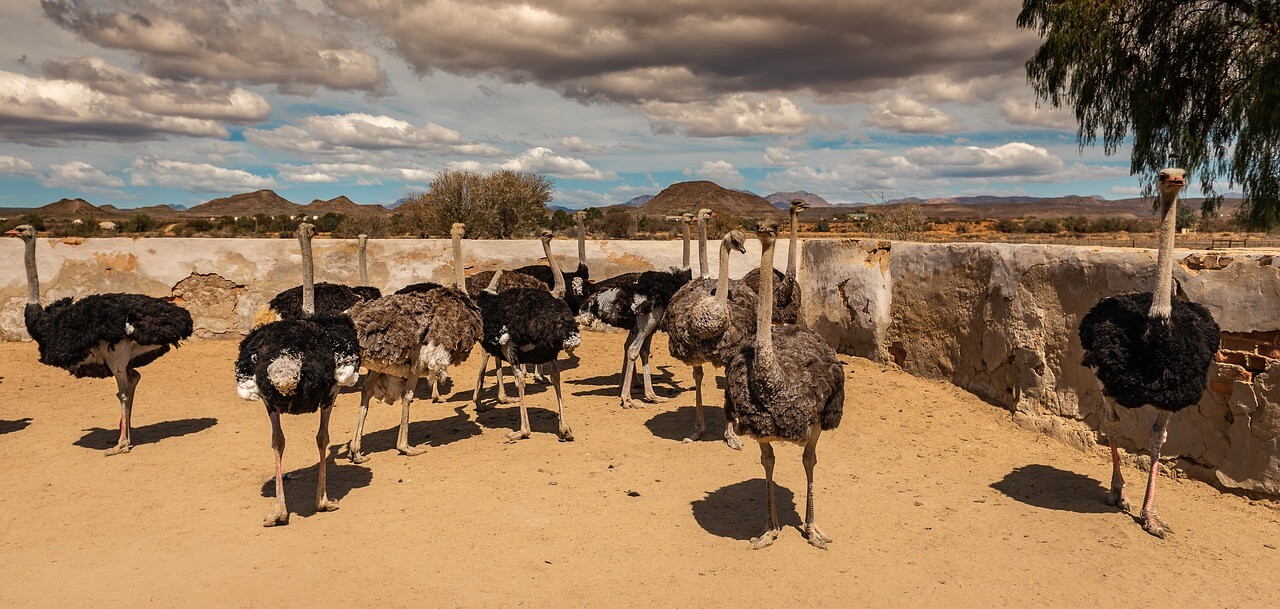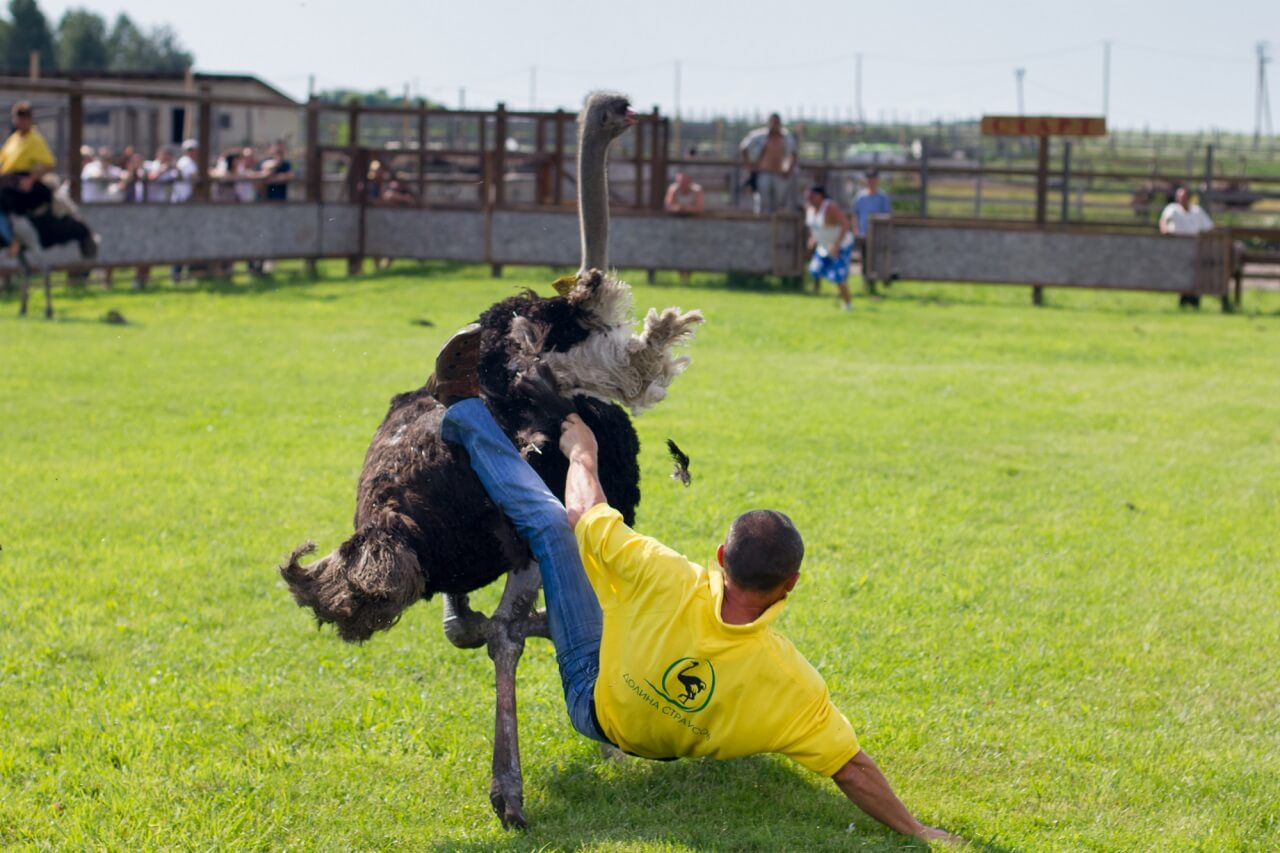Many people assume that it would be difficult to learn how to ride an ostrich, but once you learn the basics, it’s not as tough as you might think. Find a saddle, find an ostrich, and get started – these tips will help you learn the ropes.
What You'll Learn Today
Can You Actually Ride an Ostrich?

A large, flightless bird, the ostrich is the largest living bird on the planet. When it’s full-sized and fully grown, it can reach over nine feet tall and weigh more than 330 lbs!
Believe it or not, depending on where you live or where you choose to travel, you might actually be able to ride an ostrich.
In certain countries, particularly in the Oudtshoorn area of South Africa, ostrich riding is something you can do as a tourist.
Many people choose to do this while on vacation and while it is not for everyone, it can certainly be a memorable experience. You’ll need to weigh the various pros and cons of the situation before you decide to saddle up for yourself.
Does Riding an Ostrich Hurt Them?
You’ll hear different schools of thought on this.
The first argument is that since ostriches are not built to take the weight of a human being, riding them can cause some injury. They are birds and not mammals so there is no situation in the wild in which they have to withstand weight on their backs.
Over time, an ostrich’s bone structure can weaken with the repeated brunt of the weight. This can cause injury and premature aging.
The other school of thought is that since we’ve been riding ostriches for so long, it’s probably not going to cause any long lasting damage.
Many countries no longer allow ostrich riding and those that do impose weight restrictions on riders. It’s up to you whether you think it’s a good idea to ride an ostrich or not from an animal rights standpoint.
Now, there’s one important thing to remember here. Even if riding an ostrich doesn’t hurt them, be aware that it could hurt you. If you plan to ride an ostrich, there are certain precautions you need to take.
Ostriches can be quite aggressive, particularly males who get more aggressive as they age. They have long claws and will kick forward (instead of backward). Often, ostriches turn violent in response to stress and pain. They can also run quite quickly which means you could injure yourself if you happen to fall off.
How Much Weight Can an Ostrich Carry?
Most places that permit ostrich riding don’t allow it for everyone – most have weight limits in place.
These weight reactions vary but in general, riders more than 160 to 200 pounds cannot ride. Sometimes these weight limits are no more than 150 pounds.
When you sign up to ride an ostrich, be honest about your weight. You might not think that being a few pounds (or maybe a little bit more than a few pounds!) over the weight limit is a big deal, but to an ostrich, it can mean a lot.
How to Ride an Ostrich: Step by Step

If you’re planning on riding an ostrich, chances are, you’ll do it at a commercial ostrich farm (which typically raises ostriches for eggs or meat) that has clear instructions on what you are supposed to do. However, reading the process below may help lessen some of your nerves prior to saddling up!
How Do You Get an Ostrich to Like You?
Before you can ride an ostrich, you need to do a bit of casual courting first!
Give the ostrich time to warm up to you. This will not only make the experience more enjoyable but it will also make it a bit safer, too.
The best way to a woman’s heart? Through her stomach, of course!
Provide your new ostrich friend with some tasty treats, like twigs, alfalfa pellets, or, believe it or not, rocks. Ostriches actually enjoy eating rocks because it breaks up some of the roughage in their stomachs.
Preparing to Ride an Ostrich
When you ride an ostrich, there are a few steps that most farm owners will take beforehand.
First, a cloth bag will be placed over its head. This calms it down and makes it easier for the ostrich to be guided where it needs to go.
Then, you’ll need to climb up on the ostrich and lean back slightly. Place the wings of your legs and get ready!
Riding an Ostrich: Hold on Tight!
Once you’re on the ostrich, hold on tight! You’ll grip the wings during the ride, not the neck (this isn’t’ safe or comfortable for the ostrich).
The cloth bag will be removed and if you’re riding an ostrich at a farm, the ostrich will be guided away from the edge of the pen. Hopefully, they’ll stay alongside you as you ride in case you fall.
In most cases, you’ll only be able to ride for a few seconds – even a friendly ostrich won’t tolerate much more than that!
Curious about what the experience will look like? Here’s a cool video of ostrich riding for you to check out:
How Fast Can an Ostrich Go?
Although ostriches cannot fly, they are extremely fast, especially when you consider the fact that their odd body shapes should make them less than expedient!
However, they have super long legs and can run at a maximum speed of 43 miles per hour (though there are some sources that say it can briefly reach speeds of 50 miles per hour, too).
If that doesn’t seem fast to you, just consider that the ostrich is one of the fastest animals in the world. Plus, it can maintain its speed (not quite 43 miles per hour, but almost) over lengthy distances. It’s like a feathered marathon runner!
Ostriches use their wings to help them steer and become balanced at high speed. Plus, they have long, elastic legs that help them balance and accelerate. They’ve evolved this natural ability to help them escape predators, get to fresh grazing pastures, and for other reasons that we don’t quite yet understand.
Riding an ostrich isn’t an activity that everyone will be comfortable with, depending on how you feel about the ethics of the practice. However, if you’re so inclined to do so, the tips above will help you get started. Have fun!